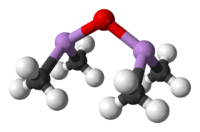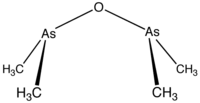Cacodyl oxide
 | |
 | |
| Names | |
|---|---|
| IUPAC name
Dimethylarsinous anhydride | |
| Identifiers | |
| 503-80-0 | |
| 3D model (Jmol) | Interactive image |
| ChemSpider | 10002 |
| PubChem | 10431 |
| |
| |
| Properties | |
| C4H12As2O | |
| Molar mass | 255.98 g/mol |
| Except where otherwise noted, data are given for materials in their standard state (at 25 °C [77 °F], 100 kPa). | |
| | |
| Infobox references | |
Cacodyl oxide is a chemical compound of the formula [(CH3)2As]2O. This organoarsenic compound is primarily of historical significance since it is sometimes considered to be the first organometallic compound synthesized in relatively pure form.[1][2]
"Cadet's fuming liquid", which is composed of cacodyl and cacodyl oxide, was originally synthesized by heating potassium acetate with arsenic trioxide. It has a disagreeable odor and is toxic. It has been used as a denaturing and warning agent.
See also
References
- ↑ Elschenbroich, C. (2006). Organometallics. Weinheim: Wiley-VCH. ISBN 9783527293902.
- ↑ Seyferth, D. (2001). "Cadet's Fuming Arsenical Liquid and the Cacodyl Compounds of Bunsen" (pdf). Organometallics. 20 (8): 1488–1498. doi:10.1021/om0101947.
This article is issued from Wikipedia - version of the 9/18/2016. The text is available under the Creative Commons Attribution/Share Alike but additional terms may apply for the media files.